How to Create a Multiaxis Morph Between 2 Surfaces Feature
Introduction
This tutorial explains how to create a Multiaxis feature with the Morph Between 2 Surfaces toolpath. The feature requires the selection of two separate geometry surfaces that are used to create the morph toolpath and the drive surfaces to which the toolpath is applied. The feature creates offsets of each surface and blends the two offsets together (morphs) to create the toolpath on the drive surfaces.
Example File
The BobCAD part file for this tutorial is available for download at: http://bobcad.com/helpfiles. If you are connected to the Internet, you can click the link provided to download and save the Morph Between 2 Surfaces Example 1 BBCD.zip file. After extracting the zip file, you can open the file to follow along with this example. In the example file provided, the stock and Machine Setup are already defined for the part. The part is simulated using the BC Table-Table machine.
In this example, a finishing type toolpath strategy is applied to the floor surface that lies between the blades of a blisk (bladed disk). It is shown how the surface normal direction defines the tool orientation and how a tilting strategy is applied to change this default tool orientation. To learn another way to create a similar program using edge curves instead of surfaces, view the Morph Between 2 Curves example, which uses the same part model.


Part 1) Add the Feature
-
In the Data-CAM Tree Manager, click the CAM Tree tab.
-
Right-click
 Machine
Setup and click Mill Multiaxis.
Machine
Setup and click Mill Multiaxis. -
In the Multiaxis Wizard, click Surface and click Morph Between 2 Surfaces.
-
Click Next>> to go to the Posting settings.
Part 2) Define the Posting Parameters
-
The Work Offset # is automatically set to the value defined in the Machine Setup.
You can change the value here to update the Work Offset # for the feature. -
Click Next>> to go to the Multiaxis Posting settings.
Part 3) Define the Multiaxis Posting Parameters
-
Notice, at the top of the dialog box, that the Use Machine Settings check box is selected.
This means that the Multiaxis Posting parameters for the feature use the same parameters as the machine that is selected in Current Settings.
You can clear the Use Machine Settings check box to define the Multiaxis Posting parameters of the feature separately from the current machine settings.
An example usage is explained later. -
Click Next>> to go to the Tool settings.
Part 4) Define the Tool Parameters
-
In the Tool Data group, clear the
 System Tool check box.
System Tool check box.
Set the Diameter to 0.500, the Flute Length to 2.500, and the Corner Radius to 0.250. -
Click Next>> to go to the Parameters.
Part 5) Select Geometry
For the geometry selections in this example, the original part model is hidden from view, and a separate layer is shown that contains only the surfaces that are necessary for this example. The position of these surfaces in the workspace is exactly the same as they are on the model.
-
To define the first surface, in the Surface Paths tab under Pattern, click First.
-
Click to select the first surface as shown next.
(In the Layers tab, the Part Model layer is hidden and the Surfaces layer is visible. The Surfaces layer is used for the geometry selections.)
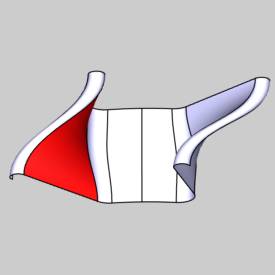
-
To confirm the selection, click
 .
. -
To define the second surface, under Pattern, click Second.
Select the second surface as shown next.
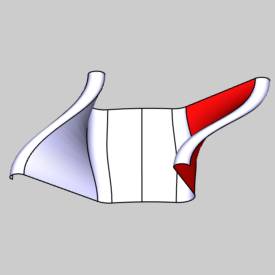
-
To confirm the selection, click
 .
. -
To define the surfaces to machine, click Drive Surfaces.
Select the four bottom surfaces as shown next.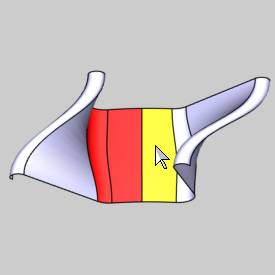
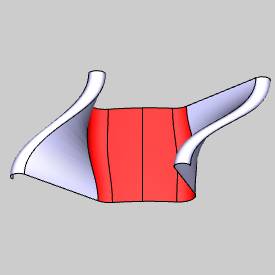
-
To confirm the selection, click
 .
.
The next step is to define the parameters for the feature.
Part 6) Define the Parameters
-
In the Area group, next to Type, select Full, Start and End at Exact Surface Edges.
-
In the Sorting group, next to Cutting Method, select One Way.
-
At the top of the dialog box, click Link.
-
Click Retracts.
In the Clearance Area group, next to Type, select Cylinder.
Confirm that the Radius is set to 6.00.
When you create a Multiaxis feature, this value is automatically set using the Clearance Plane value that you defined in the Machine Setup. After the feature is created, you edit the Clearance Plane for Multiaxis features in this location. (Editing the Clearance Plane in the Machine Setup does not update the Clearance Plane of existing Multiaxis features.)
Click OK.
-
At the bottom of the Multiaxis Wizard, click Compute.
The result is shown next.
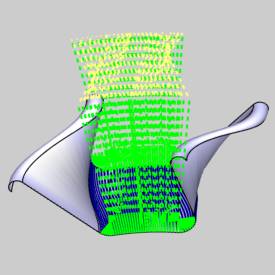
Notice that at the outer edges of the part, the toolpath retract moves are going right through the surface. The next step is to use the tool axis control to change the tool axis orientation.
Part 7) About the Surface Normal
Before continuing, it is important to understand the relationship of the tool axis orientation and the surface normal direction. The tilting strategy used in this example so far is the default option, Tilted Relative to Cutting Direction. This strategy uses the surface normal direction to define the initial tool axis orientation. If you examine the toolpath at the bottom corners of the surfaces, you can see that the surface normal direction creates a tool axis orientation that gouges the part.
The following image shows the retract moves that use the surface normal direction.

The next image shows the tool gouging as a result of the tool axis following the surface normal direction.
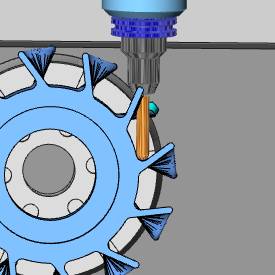
-
To view the surface normals, in the document toolbar, click
 Surface Normal. (You can also press
the N key.)
Surface Normal. (You can also press
the N key.)
(To hide the toolpath and make it easier
to view the surface normal indicators, right-click ![]() FeatureMultiaxis
and click Blank/Unblank Toolpath.)
FeatureMultiaxis
and click Blank/Unblank Toolpath.)

-
To hide the surface normals, in the document toolbar, click
 Surface Normal.
(You can also press N.)
Surface Normal.
(You can also press N.)
(If you set the toolpath to hidden, show the toolpath again using the same process.)
The tool axis orientation is resolved in the next part of this example by changing the Tool Axis Control.
Part 8) Edit the Feature and Define the Tool Axis Control
When you computed the toolpath, the ![]() Multiaxis Feature
was added to the CAM
Tree.
Multiaxis Feature
was added to the CAM
Tree.
-
To edit the feature, right-click
 Feature Multiaxis, and click
Edit.
Feature Multiaxis, and click
Edit. -
On the left side of the dialog box, click Parameters.
At the top of the dialog box, click Tool Axis Control. -
Next to Tool Axis Will, select the tilting strategy Tilted Through Curve.
Next to Curve Tilt Type, select From Start to End for Each Contour. -
To define the tilt curve, next to Tool Axis Will, click Tilt Curve.
-
In the Layer Manager, click the Layers tab.
Right-click the layer Tilt Curve, and click Show. -
Select the tilt curve as shown next.
(To hide the toolpath and make the curve geometry easier to view, in the CAM Tree, right-click Feature Multiaxis, and click Blank/Unblank Toolpath.)
Tip: When you hide any item in the CAM Tree, you can click that item, in the CAM Tree, to highlight the (hidden) item in the graphics area. When you click any other tree item, the highlighting is removed.
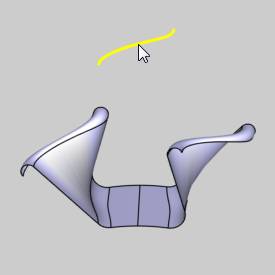
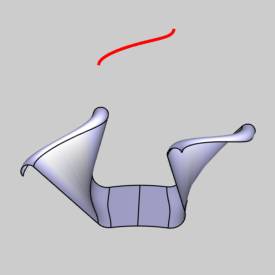
-
To confirm the selection, click
 .
. -
To add the changes, click Compute.
The result is shown next. (If you set the toolpath to Blank, repeat the same process to show the toolpath again.)
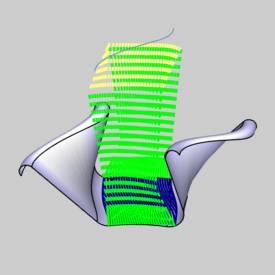
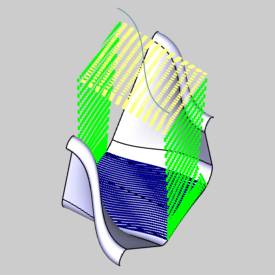
Notice that the retract moves no longer go through the part.
The tool axis orientation is now always tilted through the selected tilt curve.

Part 9) Add Leads
The toolpath is plunging directly onto the edge of the surfaces. The next step is to add leads that cause the toolpath to start past the surface edges and then feed into the part.
-
Edit the feature, and click Parameters.
At the top of the dialog box, click Link. -
In the Entry/Exit group, next to First Entry, (on the right side) select Use Lead-In.
To open the Lead-In dialog box, next to Use Lead-In, click .
.
Notice that the Use Default Lead-In check box is selected by default.
Click OK.
Next to Last Exit, (on the right side) select Use Lead-Out. -
In the Links Between Slice group, next to Large Moves, select Use Lead-In/Out.
The Link types that are now enabled all use the Default Lead-In/Out. -
To define the default leads, click Default Lead-In/Out.
In the Lead-In group, next to Type, select Tangential Line.
Next to Length, type 0.500.
To use these settings for the Lead-out, next
to Copy, click ![]() .
.
Click OK.
-
To add the changes, click Compute.
The result is shown next.
For comparison purposes, the second image shows the toolpath before adding the leads.

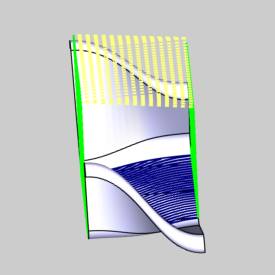
Part 10) Simulate the Program
-
To simulate the program, In the quick access toolbar, of the CAM Tree Manager, click
 .
.
To learn more about using simulation, view Getting Started with Simulation.
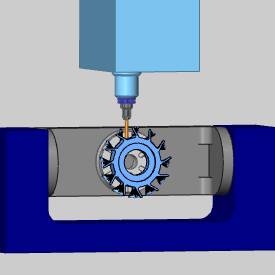
During simulation, you can see that the tool is always tilted through the defined tilt curve, and the tool plunges into an area outside of the part and then feeds into each cut.
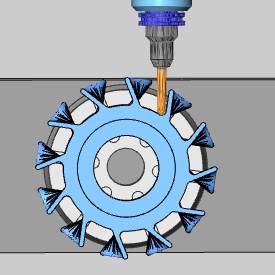
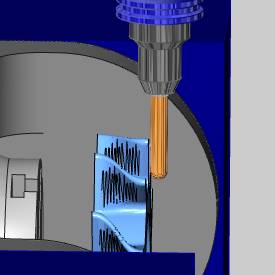
-
To close simulation, click
 Exit Simulation.
Exit Simulation.
Adjust the Machine Table Rotation
When you simulate the program, the machine table is sometimes rotated in a way that doesn't allow you to view the part without rotating the view of the machine. You can change the Angle Pair settings for the feature to modify the table rotation used in simulation and in the posted code.
- To edit the feature, in the CAM
Tree, right click
 FeatureMultiaxis,
and click Edit.
FeatureMultiaxis,
and click Edit. - Click the
Multiaxis Posting icon in the tree.
- Clear the Use
Machine Settings check box.
- In the Angle
Pair group, next to Use,
select Other Solution.
When you simulate the program again, you can now view the part being cut from the opposite side of the machine.
The table is rotated to use the other solution to the rotation angles of the primary and secondary rotary axes (angle pair). This changes the posted output of the program as well as the simulation.
Tip: You don't have to compute the toolpath to update this setting for simulation, but you must Post the program to update the code if has already been posted.
This concludes the tutorial.
